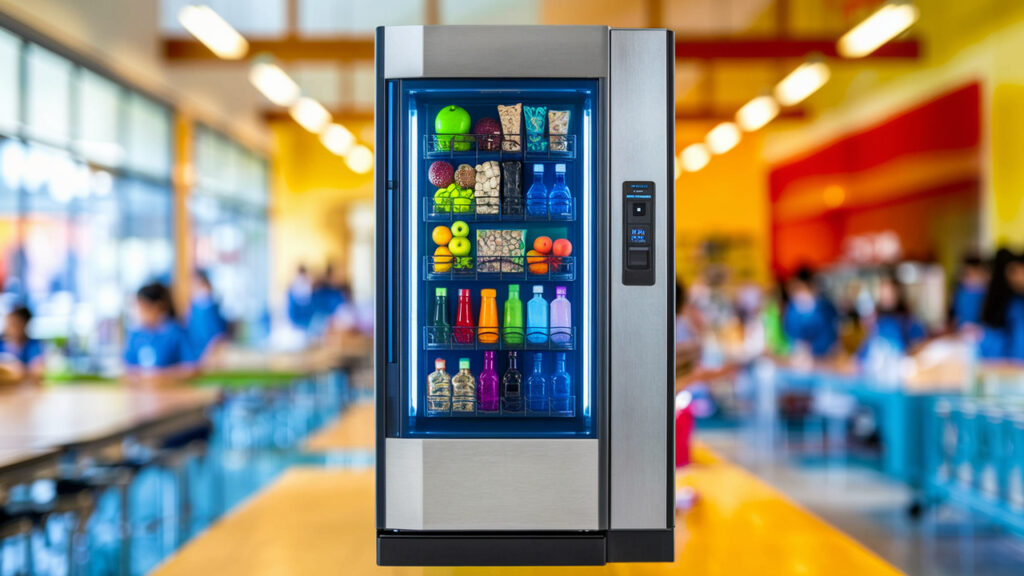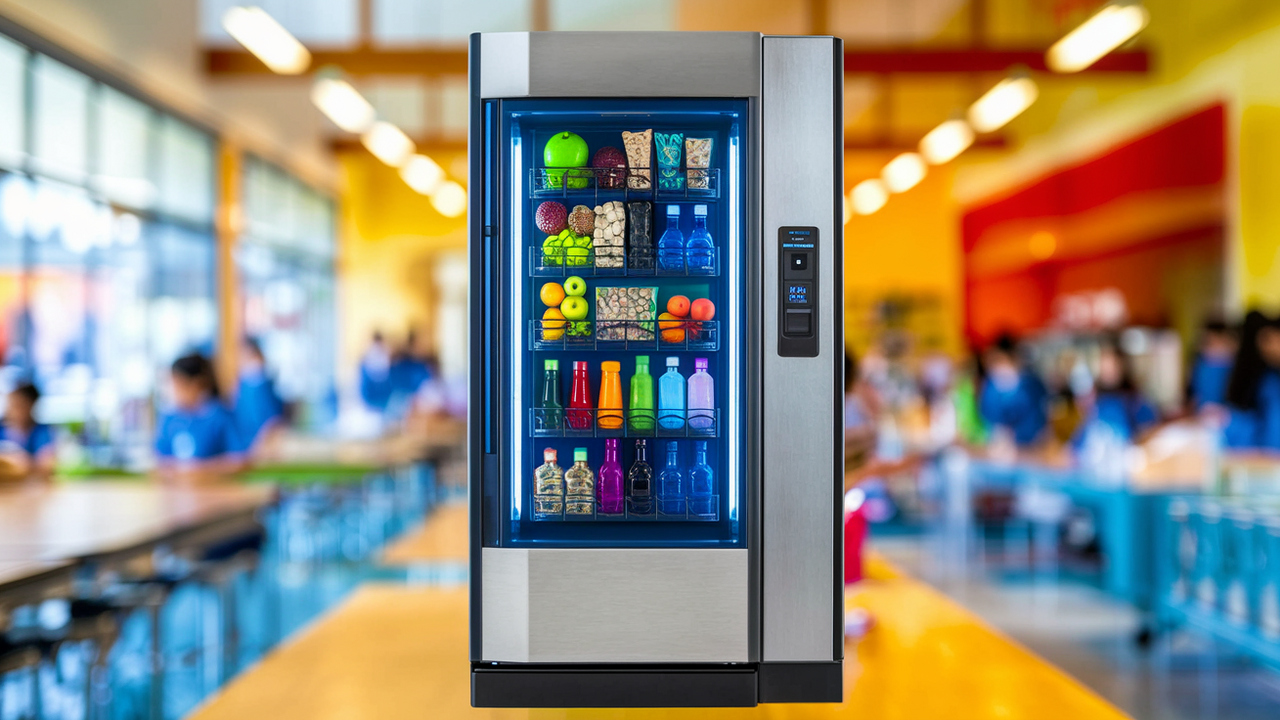Best Vending Machines for Schools: What to Know Before Buying
When I first considered placing vending machines in schools, I thought it would be a simple plug-and-play setup. But I quickly learned there’s more to it—school environments have unique rules, safety standards, and student needs.
Whether you’re placing a machine in a public school, private academy, or even a college campus, this guide will help you choose the best vending machines for schools and avoid common mistakes.
Below, I’ll share top-rated vending machines available on Amazon, plus key things you need to know before making a purchase.

Table of Contents
1. KoolMore Combo Vending Machine for Snacks and Drinks
This is a fantastic option for middle and high schools that allow both snacks and drinks. It’s compact, reliable, and comes pre-installed with a card reader for contactless payments—something students and staff appreciate in 2025.
Why it works well in schools:
- Easy to load and restock
- Accepts cards, mobile payments (tap-to-pay)
- Adjustable shelves for a mix of snacks and drinks
- Compact design that fits in tight hallways or cafeterias
Buy it on Amazon:
KoolMore Snack & Drink Vending Machine
2. VEVOR Dual-Zone Vending Machine
Schools often need to meet specific nutritional guidelines. This combo machine allows you to stock healthy snacks and cold drinks in separate temperature zones. Ideal for student wellness centers, teachers’ lounges, or college dorms.
Highlights:
- Dual temperature zones (cold drinks and room-temp snacks)
- Built-in card reader
- Compact and tamper-resistant
- User-friendly interface
Order on Amazon:
VEVOR Combo Vending Machine
3. Selectivend WS3000 ADA-Compliant Snack Machine
If your school requires ADA compliance or a more professional, secure setup, this machine is worth the investment. It’s ideal for public schools, community colleges, and shared education spaces.
Key features:
- ADA compliant
- Large snack capacity (40+ selections)
- Accepts bills, coins, and credit cards
- Durable and secure for busy student areas
Check price on Amazon:
Selectivend School Vending Machine
4. Manovix Touchscreen Snack & Beverage Machine
For modern school environments that want to impress—think STEM-focused campuses or charter schools—the Manovix machine delivers. It includes a sleek touchscreen, programmable options, and a compact, elegant design.
Why I recommend it:
- 10” touchscreen interface
- Accepts mobile and card payments
- Sleek, clean design
- Great for faculty lounges or student rec centers
Buy it here:
Manovix Touchscreen Machine on Amazon
What to Know Before Buying a School Vending Machine
Buying a vending machine for a school is different than buying one for an office or gym. Here’s what I’ve learned matters most:
1. Follow School Nutrition Guidelines
Many K-12 schools must follow federal or state vending nutrition standards. You may be restricted from selling candy, soda, or chips. Look into “Smart Snacks in School” standards if you’re in the U.S., or ask school administrators what’s allowed.
2. Prioritize Safety and Tamper-Proof Features
Kids can be curious—or rough. Choose machines with tamper-proof locks, shatter-resistant glass, and reliable product sensors. The last thing you want is a jammed item or a student trying to shake the machine.
3. Accept Card and Mobile Payments
Most students don’t carry cash. Machines that support tap-to-pay, Apple Pay, or school cards increase sales and reduce downtime from coin jams or stuck dollar bills.
4. Keep It Simple and Intuitive
Students of all ages use vending machines, so make sure yours has a clear interface, visible product display, and easy-to-use buttons. Touchscreen models work great for older students, but for elementary schools, simplicity is key.
5. Consider Healthy Branding
Schools like machines that promote better choices. Look for machines with “Healthy Snacks” signage or wrap options. You can also stock the machine with Amazon-sourced snacks like trail mix, protein bars, veggie chips, and flavored water to stay compliant and profitable.
6. Get Written Approval from Administration
Don’t buy the machine until you have written confirmation from the school or district. Ask if there are placement fees, sharing agreements, or restrictions on vending hours. These details matter, especially for public schools.
Final Thoughts
If you want to succeed with school vending in 2025, go beyond just placing a machine—you need to place the right machine. Prioritize security, compliance, and convenience, and your vending business can provide steady passive income while also serving the student community well.
All the machines listed above are available on Amazon, making them easy to purchase, track, and get delivered directly to your business or the school.
One of the best things about placing vending machines in schools is that the audience is consistent. Students, teachers, and staff are there every day, and their routines rarely change. That means once your machine becomes part of their daily habits, you can expect steady, repeat sales without much fluctuation.
In my experience, schools are especially good locations if you can find spots with natural foot traffic, like near cafeterias, gymnasiums, or faculty lounges. These are places where people naturally gather and want a quick snack. I try to avoid areas that are too far from main hallways or hidden behind locked doors.
Another benefit of vending in schools is the long-term placement potential. If you do things right—like keeping your machine clean, well-stocked, and aligned with the school’s values—you can keep that spot for years. I’ve had machines in schools that became permanent fixtures simply because they added convenience and value.
Keep in mind that you’re serving minors, so being responsible matters. Avoid stocking anything questionable or sugary if your school has nutrition standards in place. Instead, focus on healthier, portion-controlled snacks that are both tasty and compliant. Brands like Nature Valley, Clif Bar, and PopCorners do well in these settings.
If you’re stocking drinks, avoid sugary sodas unless you’re in a private school that allows them. Instead, go with options like low-sugar juice boxes, flavored water, or coconut water. These items still satisfy a student’s craving for flavor but keep you within healthier guidelines.
I also recommend checking if your machine offers programmable settings for school hours. Some machines allow you to restrict purchases during certain times—like before lunch or after school—based on the school’s preferences. This small feature can help you stay in compliance and build trust with the administration.
When working with elementary or middle schools, you might want to keep the product pricing simple—like even dollar amounts. Younger students often struggle with change, and having items priced at $1.00, $1.50, or $2.00 makes the experience easier for everyone, especially if they still use cash.
Another helpful tip is to label items clearly inside the machine. If you’re offering healthy or allergen-sensitive products, mark them with clear stickers or separate slots. This helps students with dietary restrictions avoid confusion and builds a reputation for being thoughtful and inclusive.
If you ever get the chance, offer to sponsor school events or donate a portion of the profits. I’ve personally used this strategy and it worked wonders. Even donating $10–$20 per month from a machine’s profits toward student activities builds goodwill and often results in better placement opportunities.
Maintenance in schools is surprisingly low-effort—if you keep the machine clean and restock consistently. I aim to check my school machines once a week. Sometimes they only need a quick top-off, other times I rotate inventory to keep things fresh and appealing. Either way, the schedule is simple and reliable.
Security is rarely an issue if your machine is placed in a supervised area. However, it’s still smart to choose machines with anti-theft locks, reinforced doors, and a secure coin vault. Peace of mind matters—especially when you’re not on-site daily.
Finally, vending in schools is more than just profit—it’s about providing value to the community. You’re giving students a quick snack between classes, offering teachers a caffeine boost, and helping the school avoid the hassle of managing snacks themselves. When you treat the opportunity with care and professionalism, your machines won’t just make money—they’ll make a difference.

